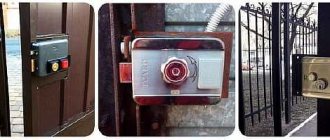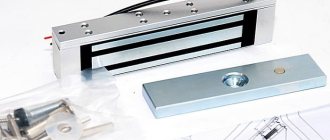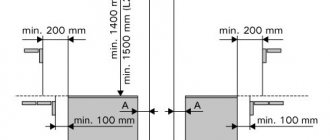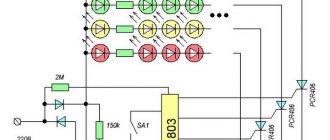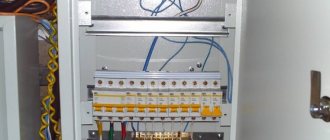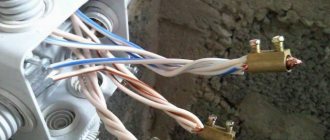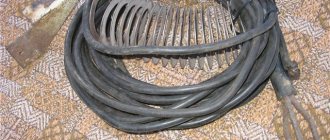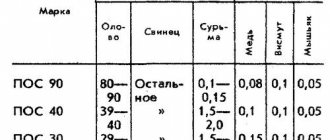DEVICE FOR INTERIOR DOORS INSTALLATION
The most important element of the actuator of access control and management systems (ACS) is an electromagnetic lock. It is installed directly on the door and is controlled remotely via an electrical signal.
Its task is to restrict the passage of unauthorized persons into residential, public or industrial premises. Magnetic contact sensors that monitor the position of the door can be used in conjunction with it.
The wide distribution of locking devices of this type is facilitated by their high reliability. They firmly hold the door in the closed position, are not afraid of aggressive environments and work at any temperature, which is important for their outdoor use.
The electromagnetic lock, designed to work as part of an access control system, has a simple structure. Its body houses an electromagnet consisting of a core and a winding. The core material does not have a magnetic memory effect, which contributes to the efficiency of control.
It is usually assembled from the W-shaped plates of steel used in most transformers, although all-metal parts are also available.
The coil winding contains several hundred turns of copper wire. The current passing through them creates a powerful magnetic field that can firmly hold the door in the closed position.
The body is made of non-magnetizable materials:
- stainless steel;
- aluminum;
- plastics
It has a device for mounting on the canvas or door frame. The kit includes an iron plate that secures the door in the closed position. The electrical circuit often includes a bidirectional protection diode that can reduce voltage surges during switching.
To quickly remove residual magnetization, electric capacitors are used.
The operating voltage for most magnetic locks is 12 Volts. Minor deviations are allowed, but they are undesirable. At lower values, operating efficiency and holding force are sharply reduced. When the voltage increases, the winding may overheat. Power consumption is low and amounts to several watts.
Design and principle of operation of electromagnetic locks
Although electromagnetic locks from different manufacturers may differ in design, they operate on the same principle. The door closes and opens due to the presence of an electromagnet inside the device. You can control such a locking device by pressing a button or by entering a special code.
The quality and reliability of the lock will depend on the strength of the electromagnet used. The larger it is, the more securely the metal plate holding the doors is fixed.
In the event of a sudden power outage, the electromagnetic lock will not be able to fulfill its intended purpose, so it is recommended to additionally install an autonomous power source or a conventional mechanical lock.
The reliability of door fixation with an electromagnetic lock depends on the holding force of the built-in magnet
To ensure reliable protection of a home, industrial enterprise or territory, an independent power source must be installed to control the electromechanical lock. If the main power is turned off, the system automatically goes into offline mode, so the safety of the home will not be threatened.
The operating principle of an electromagnetic lock is simple and clear. The main part with a magnetic device is attached directly to the door frame and is powered from a DC voltage source. The locking plate is attached to the door leaf. When power is applied, the electromagnet is activated and the strike plate is attracted to it, thereby ensuring reliable locking of the door. When you press the button that controls the lock, the power supply is turned off, after which the plate moves back, allowing the door to open.
Internal organization
The electromagnetic lock consists of the following elements:
- Housing - it has devices for reliable fixation and is made of non-magnetizable material:
- of stainless steel;
- aluminum;
- plastics.
- The core is located inside the housing and is made of a material that does not have magnetic memory, so control occurs quickly. It can be all-metal or assembled from W-shaped steel plates.
- The winding is also located in the lock body and consists of several hundred turns of copper wire. As electric current passes through the winding, a powerful electromagnetic field is created that reliably holds the core.
The main element of an electromagnetic lock is the winding - when an electric current passes through it, a magnetic field is created that attracts the strike plate
- An iron plate that ensures reliable fixation of the door when closed.
- Electrical elements. Typically, such locks have a double-directional protective diode in their circuit, which makes it possible to reduce voltage surges that occur when switching the lock. To remove residual magnetization, capacitors are installed.
- The control system can be either a button, a special code device or an electronic key.
To power almost any electromagnetic lock, a constant voltage of 12 V is required . It may change slightly, but this is not desirable. If the voltage decreases, the holding force of the electromagnet decreases and the reliability of the lock also decreases. When the voltage increases, the winding overheats, which can lead to its failure. High-quality modern electromagnetic locks consume only a few watts, so their installation will not greatly affect the overall energy consumption.
Advantages and disadvantages
Electromagnetic locks have many advantages, which explains their great popularity:
- long service life - on average 10–15 years. Ensured due to the absence of moving parts;
- large selection of models. They can be mortise, overhead, tear-off or shear;
- high reliability. Such a lock cannot be picked using drilling or a master key;
- the ability to remotely control the door opening/closing process;
- possibility of installation on any doors, including metal, plastic, wood, glass;
- simple installation and maintenance;
- minimum power consumption - approximately 3-5 W;
- ability to work both indoors and outdoors;
- affordable price. A simple electromagnetic lock with a hold of 180–300 kg retails for 1000–1500 rubles.
Like any other type of lock, this locking device also has its disadvantages:
- dependence on the availability of power in the network, therefore, for reliable operation of such a lock, it is necessary to install an autonomous power supply;
- higher cost than a mechanical lock, which is justified by significantly greater reliability and ease of use;
- the need to have certain skills in working with electrical networks for independent installation.
Kinds
These locks are classified according to several parameters.
According to the locking principle
There are two types:
- Sliding. The action of the mechanism is based on the shift of the anchor. Most models are mortise. When installing, it is important to follow the step-by-step instructions.
- Retaining. The anchor acts on separation. Overhead and mortise models are available; mortise ones have a low adhesive force.
Overhead retaining locks are installed much more often.
By type of control
Available:
- With reed switch elements. No voltage is needed to control operation. Due to the action of the magnet, contact occurs and the required voltage level is maintained.
- With Hall sensors. They are a microcircuit. Additional power is required for operation.
The latter type provides increased security due to sensitive sensors.
By mounting method
There are:
- Mortise. It is completely built into the wicket leaf.
- Semi-mortise. It is mounted inside the door, but some of the elements are visible from the outside.
- Invoices. It is fixed on top of the sash on metal corners.
Repair of electromagnetic locks
Although the electromagnetic lock has a long service life and high reliability, like any other equipment, it can fail after a while. The main factors that can lead to lock failure:
- human - improper operation of the lock;
- natural - the negative impact of external factors, which leads to damage to wiring and fasteners.
The main failures of an electromagnetic lock are associated with weakening or loss of the holding force or with the appearance of residual magnetization. The force may disappear due to a break in the wires that supply power to the lock, a breakdown of the power source, or a failure of the electromagnet coil.
The main malfunctions of the electromagnetic lock and how to eliminate them:
- Coil repair. To check the functionality of the electromagnetic lock coil, you need to use a tester. The resistance should be several tens of ohms, it all depends on the model and power of the lock. If the resistance does not correspond to the parameters stated in the instructions, the coil is replaced, and if the block is monolithic, then the entire magnet.
- Residual magnetization. It appears when a capacitor breaks down, which serves to create damped oscillations when the power is turned off, removing the remnants of the magnetic field. To eliminate such a breakdown, you need to connect a 25 V capacitor in parallel to the lock terminals. For most domestically produced locks, a capacitor capacity of 220 µF is sufficient, and for foreign-made models, the capacitance can be from 220 to 1000 µF and is selected individually.
- Coil break. This malfunction can be eliminated by replacing the coil or restoring its functionality in specialized workshops.
Video: electromagnetic lock repair
Advantages and disadvantages of magnetic locking mechanisms
Mechanisms with magnets have a number of advantages:
- quiet operation;
- simple installation;
- significant service life;
- availability for purchase.
Disadvantages of mechanisms with magnets:
- metal objects, as well as metal dust, stick to the magnet;
- a magnet operates in a certain field, so it is compared to a door closer;
- The electric locking device requires a constant supply of electricity to operate.
Despite a number of disadvantages, magnetic mechanisms are popular.
Tips for use
If the electromagnetic lock has been installed correctly, then usually no problems arise during its operation. You just need to follow simple rules for caring for the equipment:
- During operation of the lock, it is necessary to periodically check the condition of the plate. Under the influence of moisture, plaque may appear on it, which leads to a weakening of the holding force;
- It is recommended to periodically check the fastenings of the lock and strike plate. Over time, under the influence of loads, the screws may weaken, so they must be tightened periodically;
- When using a lock with a controller implemented as a separate device, you must have a master key. It is used to encode cards. It is recommended to store it in a mounting box, this will avoid coding problems that arise when one of the users loses the access card. It is recommended to place the controller itself in a sealed bag to protect it from moisture.
Classification
There are several criteria by which EMRs differ:
Operating principle.
According to the principle of operation, electromagnetic locks are divided into:
- Containing.
- Shear.
Restraining locks, the anchor of which works to pull away, are:
- Invoices.
- Mortise.
Shift locks, the anchor of which works to shift the locking tongue, are designed for installation inside the door leaf.
Control method
EMZ can be controlled in two ways:
- One button, a simple press of which causes the door to open.
- Using electronic components such as:
- Hall sensor - controls the operation of the lock.
- Magnetic contact sensor (reed switch) that controls the movement of the door.
Coating of work surfaces
Since the working elements of the lock (core and anchor plate) are made of low-alloy steel, they are susceptible to corrosion. To protect against corrosion (rust), a protective coating is applied to the working surfaces. Usually varnishing, galvanizing or nickel plating is used.
OLEVS electromagnetic locks use a zinc coating to protect against corrosion.
| Coating | Aesthetics | Protective properties | Price | Effect on the holding force of the magnetic lock |
| Varnishing | Low | Low | Low | Slightly reduced due to increased working gap |
| Galvanizing | Average | High | Average | Slightly reduced due to increased working gap, zinc is a non-magnetic metal (diamagnet) |
| Nickel plating | High | High | High | Doesn't change. Nickel is a magnetic metal (ferromagnetic) |
If, as a result of long-term use, the lock has lost its protective coating, and corrosion of the working surfaces of the core and armature has begun (rust has appeared), this will not affect the operation of the lock - the holding force will not change. And to restore the appearance, you can remove the rust with fine sandpaper and then cover the working surfaces with a thin layer of varnish.
